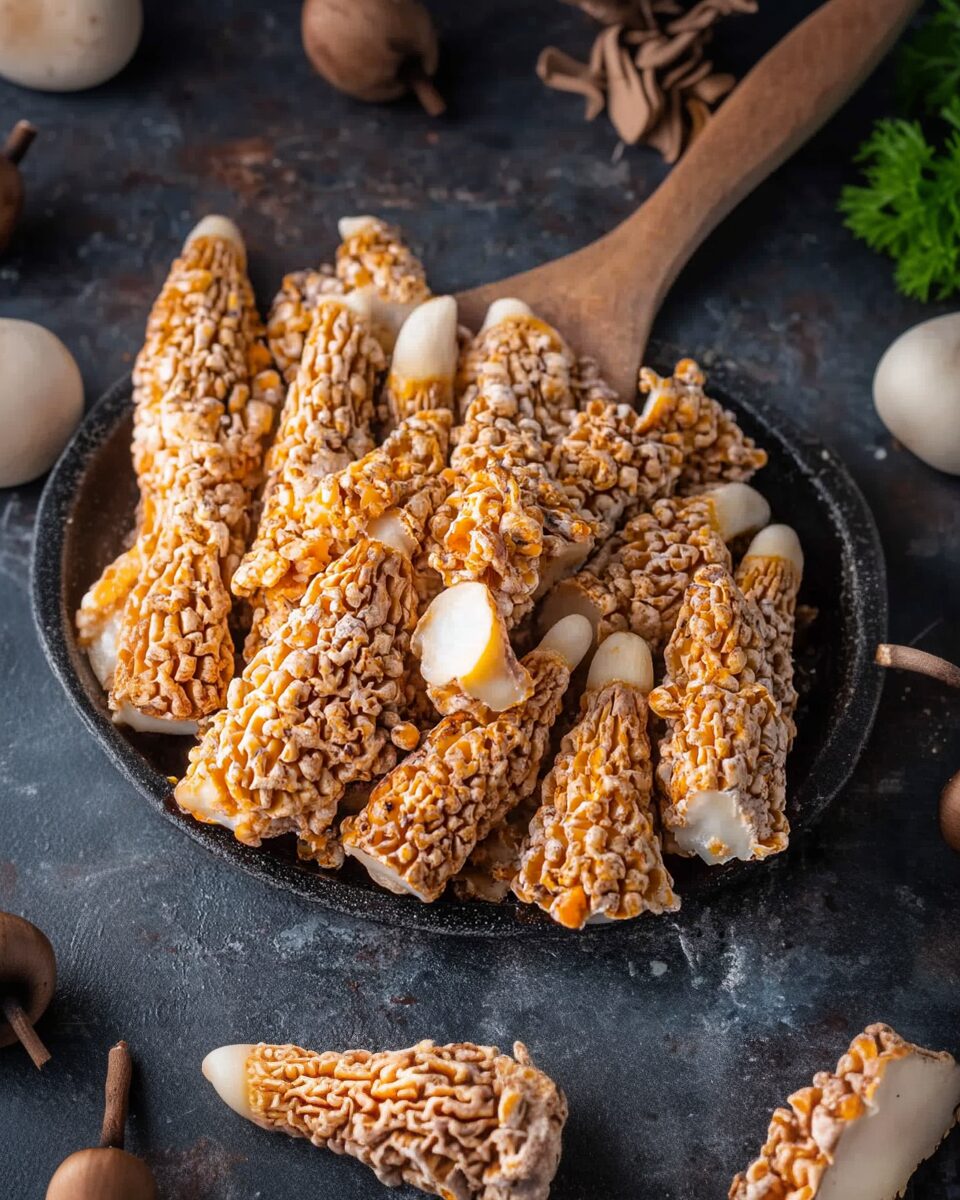Mushroom Duxelles is a classic French preparation that transforms finely chopped mushrooms into a rich, flavorful mixture cooked with shallots, fresh thyme, and sherry. Traditionally used as a stuffing in dishes like Beef Wellington, this versatile concentrate can enhance sauces, soups, and appetizers. It’s an excellent way to preserve mushrooms and add depth to various culinary creations.
Full Recipe:
Ingredients
- 1 pound fresh wild mushrooms, cleaned and roughly chopped
- 1 tablespoon shallot, diced
- ½ teaspoon kosher salt
- ¼ teaspoon freshly ground black pepper
- 2 tablespoons oil (plus extra for roasting, if needed)
- ¼ cup dry sherry (or dry white wine as a substitute)
- ½ teaspoon fresh thyme, chopped
Directions
- Finely Chop the Mushrooms: Using a chef’s knife, finely chop the mushrooms by hand. Alternatively, pulse them in a food processor until finely chopped, being careful not to over-process into a paste.
- Sauté Shallots: Heat a large skillet over medium heat and add the unsalted butter. Add the diced shallots and cook until translucent.
- Cook the Mushrooms: Add the chopped mushrooms and cook, stirring occasionally. Season with salt, pepper, and chopped fresh thyme. Continue cooking until the mushrooms release their liquid.
- Evaporate Liquid: Allow the mushroom liquid to evaporate completely, which should take about 10 minutes.
- Deglaze the Pan: Once the pan is dry, deglaze by adding the sherry or white wine. Cook until the liquid has evaporated. Taste the mixture and adjust seasoning with additional salt and fresh thyme as needed.
- Optional Drying/Roasting: If the duxelles mixture appears too moist, spread it onto a baking sheet lined with parchment paper. Lightly spray or brush with oil, then bake at 400°F (200°C) for 10-15 minutes, stirring occasionally, until the mixture reaches the desired consistency.
- Store for Later Use: Allow the duxelles to cool, then refrigerate or freeze for future use. Freezing in ice cube trays and storing in a resealable vacuum bag allows for easy portioning.
Nutritional Facts
Per serving (based on 2 cups total yield):
- Calories: 202 kcal
- Carbohydrates: 9 g
- Protein: 7 g
- Fat: 15 g
- Saturated Fat: 1 g
- Polyunsaturated Fat: 4 g
- Monounsaturated Fat: 9 g
- Trans Fat: 0.1 g
- Sodium: 595 mg
- Potassium: 759 mg
- Fiber: 2 g
- Sugar: 5 g
- Vitamin A: 0.2 IU
- Vitamin C: 5 mg
- Calcium: 12 mg
- Iron: 1 mg
The Origins of Mushroom Duxelles
Mushroom Duxelles dates back to the 17th century and is named after a French noblewoman, the Marquise de Duxelles, who is believed to have inspired the creation of this dish. The original version was likely more simplistic than the one we recognize today, consisting primarily of finely chopped mushrooms, herbs, and butter. It was likely intended as a garnish or condiment for rich meats, making it a luxurious addition to the table.
Over time, the recipe evolved as chefs added wine and other ingredients to enhance its depth. By the 19th century, the dish became a key component in French haute cuisine. It was popularized as a filling for Beef Wellington, a famous dish created by chef Marie-Antoine Carême. Since then, Mushroom Duxelles has found its way into many European and international kitchens, valued for its ability to transform any dish into something extraordinary.
The Versatility of Mushroom Duxelles
One of the standout features of Mushroom Duxelles is its versatility. While the recipe traditionally includes mushrooms, shallots, and herbs, variations abound. Different types of mushrooms can be used, ranging from wild mushrooms like chanterelles and morels to the more common button or cremini mushrooms. The choice of mushrooms greatly influences the flavor profile, with wild mushrooms adding an earthier and more complex taste.
This mixture can be used in a variety of ways. It’s most famously seen as the filling for Beef Wellington, where it acts as a savory complement to the beef and puff pastry. However, its potential doesn’t stop there. Duxelles can be spread on toast or crackers for an elegant appetizer, used as a topping for meats like chicken or lamb, or stirred into sauces for an added layer of flavor. Additionally, it’s an excellent addition to soups, risottos, or omelets, offering a rich, umami-packed twist.
Making the Perfect Mushroom Duxelles
The key to a successful Mushroom Duxelles lies in the careful preparation and cooking of the mushrooms. The first step is to finely chop the mushrooms, which ensures that they will cook down into a fine, paste-like consistency. This allows the mushrooms to absorb the flavors of the shallots, thyme, and wine, resulting in a smooth and flavorful mixture.
When sautéing the mushrooms, patience is crucial. It’s essential to cook them long enough to release their moisture, allowing it to evaporate completely. This ensures that the final mixture has a concentrated flavor without excess liquid. Adding wine, such as dry sherry or white wine, helps deglaze the pan and enhances the flavor of the mushrooms, providing a rich, savory depth that is the hallmark of this dish.
The optional roasting step is an excellent way to reduce the moisture further, especially if the mixture seems too liquid after the initial cooking process. Roasting at a high temperature helps to intensify the flavors and gives the Duxelles a firmer texture, making it easier to handle and use in various recipes.
Health Benefits of Mushroom Duxelles
While Mushroom Duxelles is a rich, flavorful dish, it also offers several health benefits, particularly due to the inclusion of mushrooms. Mushrooms are an excellent source of vitamins, minerals, and antioxidants, making them a nutritious addition to any meal. They are particularly high in B vitamins like riboflavin, niacin, and pantothenic acid, which are essential for energy production and brain function.
Mushrooms are also a good source of minerals like selenium, copper, and potassium, which support immune function, cardiovascular health, and nerve function. Additionally, mushrooms contain antioxidants such as ergothioneine and glutathione, which help protect the body against oxidative stress and inflammation. These antioxidants contribute to a reduced risk of chronic diseases such as cancer, heart disease, and neurodegenerative conditions.
While the addition of butter and oil in Mushroom Duxelles does add calories and fat, using them in moderation can provide healthy fats that support the absorption of fat-soluble vitamins like vitamin D, which is abundant in certain types of mushrooms. For those looking to create a lighter version, the amount of butter and oil can be reduced or substituted with olive oil or other healthier options.
The Art of Pairing Mushroom Duxelles
Pairing Mushroom Duxelles with the right ingredients can enhance its natural flavors and create a harmonious dining experience. For example, it pairs wonderfully with meats like beef, pork, and chicken. The richness of the mushrooms complements the savory depth of roasted meats, making it a perfect filling for dishes like Beef Wellington. It also works well with roasted vegetables, adding an earthy component that balances out sweeter flavors.
In addition to meats and vegetables, Mushroom Duxelles can also be paired with cheeses. Soft cheeses like goat cheese or brie complement the richness of the Duxelles, creating a smooth, creamy contrast. For a lighter pairing, it can be served with a fresh salad, where the crispness of the greens provides a refreshing counterpoint to the dense, earthy flavor of the mushrooms.
For those who enjoy wine, Mushroom Duxelles pairs beautifully with a variety of wines, especially those with earthy, complex flavors. A well-balanced Pinot Noir, with its bright acidity and subtle earthiness, complements the mushrooms’ flavor without overpowering it. Similarly, a rich Burgundy or a well-aged Bordeaux can enhance the savory characteristics of the dish, creating a sophisticated pairing.
Mushroom Duxelles in Modern Cuisine
While Mushroom Duxelles is rooted in classical French cooking, it has found a place in modern cuisine as well. Chefs around the world have embraced this dish and adapted it to suit contemporary tastes and dietary preferences. Today, it is not uncommon to see Mushroom Duxelles incorporated into vegan and vegetarian dishes. The mushrooms themselves provide a meaty texture, making them an excellent choice for plant-based meals.
In modern kitchens, Mushroom Duxelles is often used as a filling for vegetarian pastries, served atop grilled tofu or tempeh, or stirred into pasta sauces. Its ability to mimic the umami depth of meat-based dishes makes it a popular choice for those looking to add complexity to their meals without relying on animal products. Furthermore, the increasing popularity of foraged mushrooms and wild ingredients has led to new variations of Duxelles, with chefs experimenting with different types of mushrooms to create unique and innovative versions of the dish.
Conclusion
Mushroom Duxelles is a timeless and versatile dish that continues to captivate chefs and home cooks alike. Whether used as a filling for pastries, a topping for meats, or a savory addition to sauces and soups, it brings a rich, earthy flavor that elevates any meal. The history of this dish, its adaptability, and its potential health benefits make it a standout in both traditional and modern cooking.






